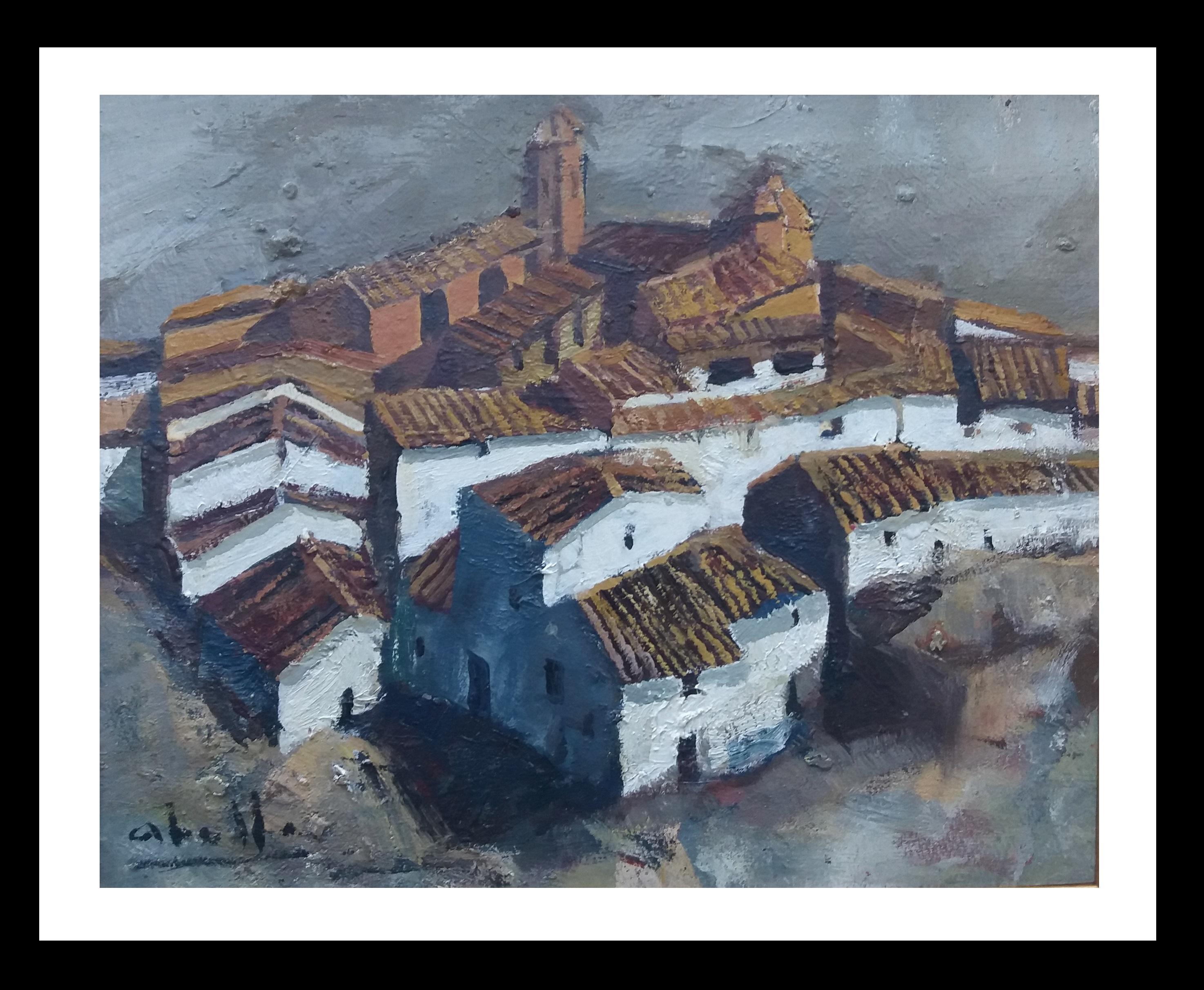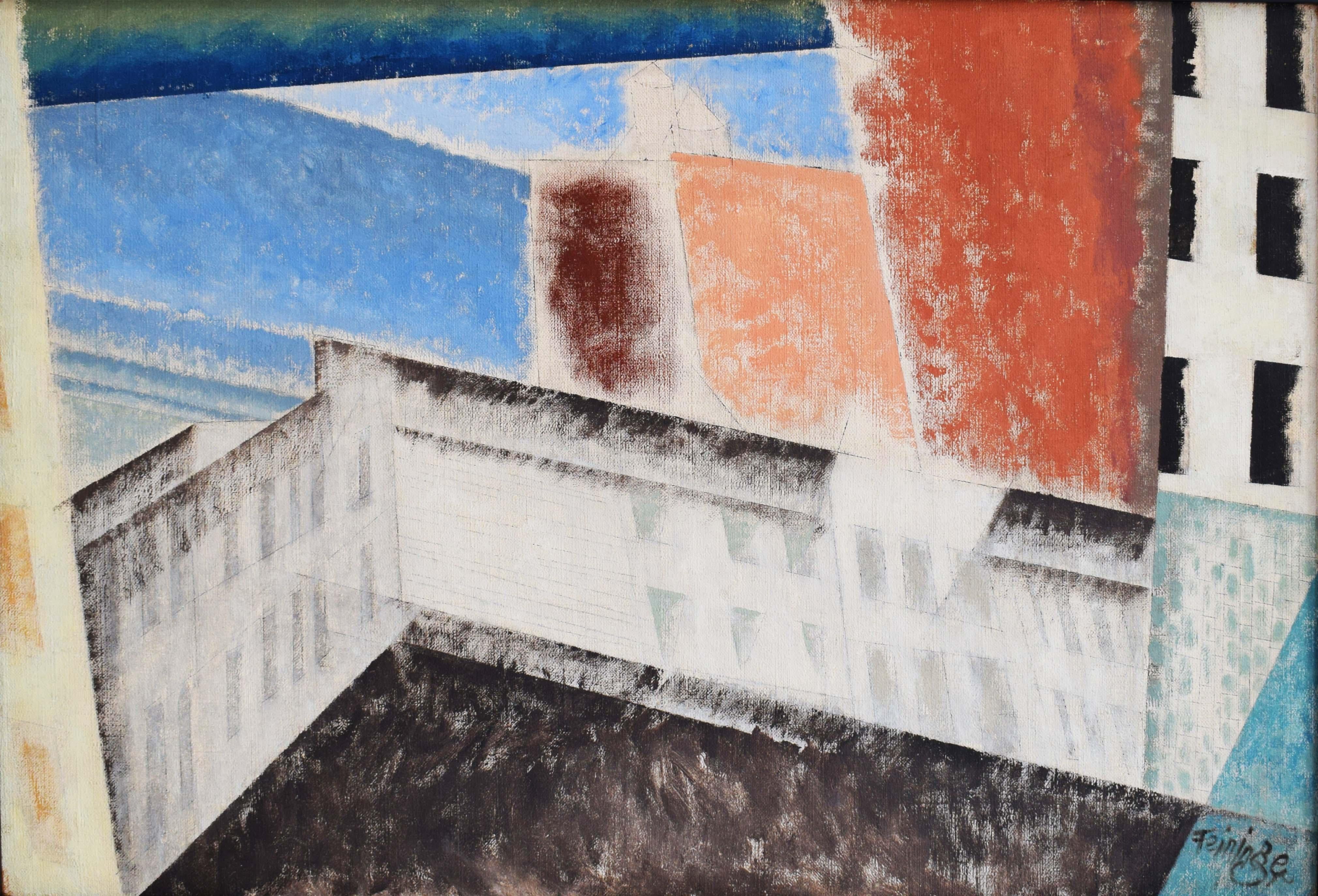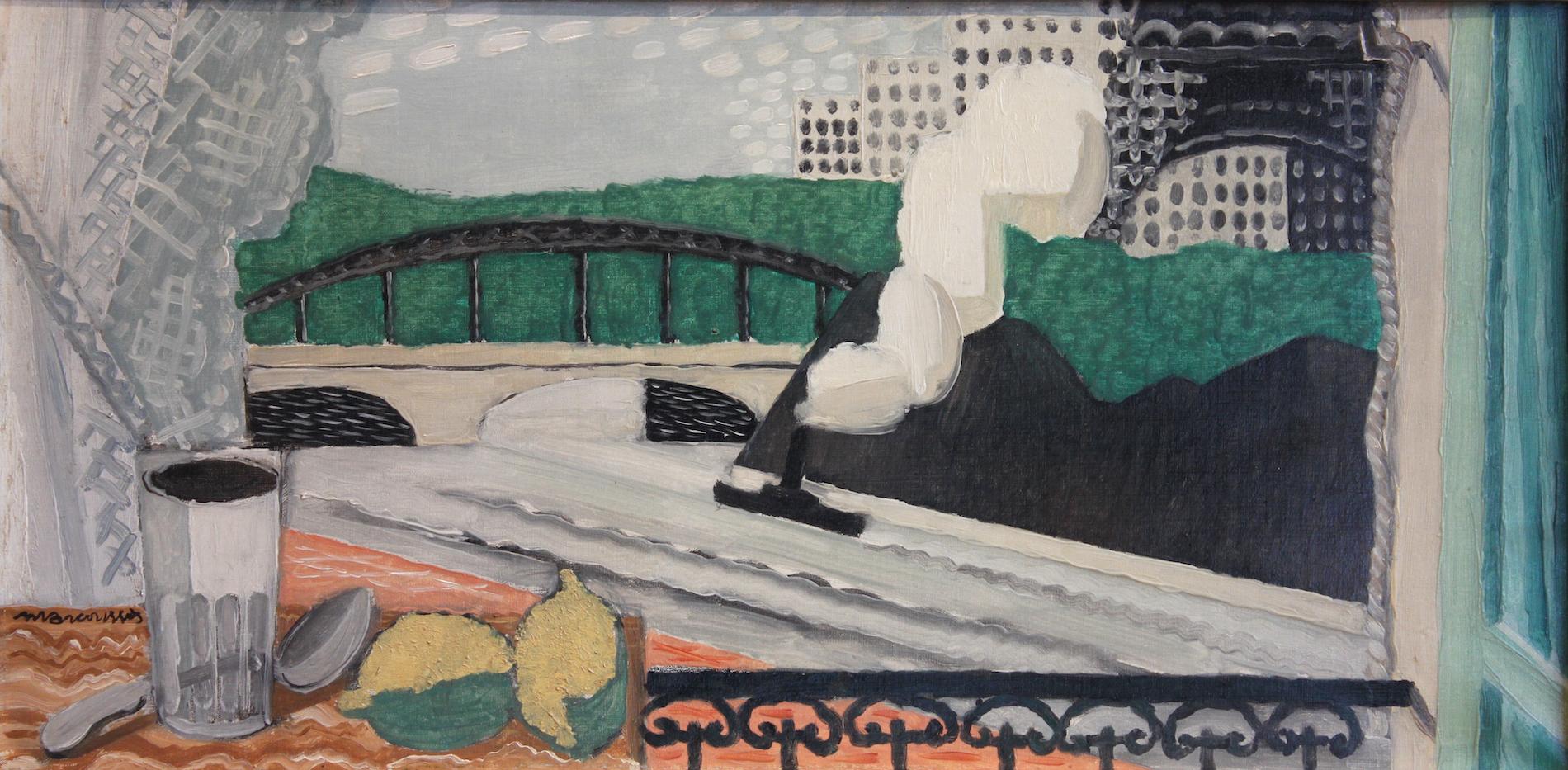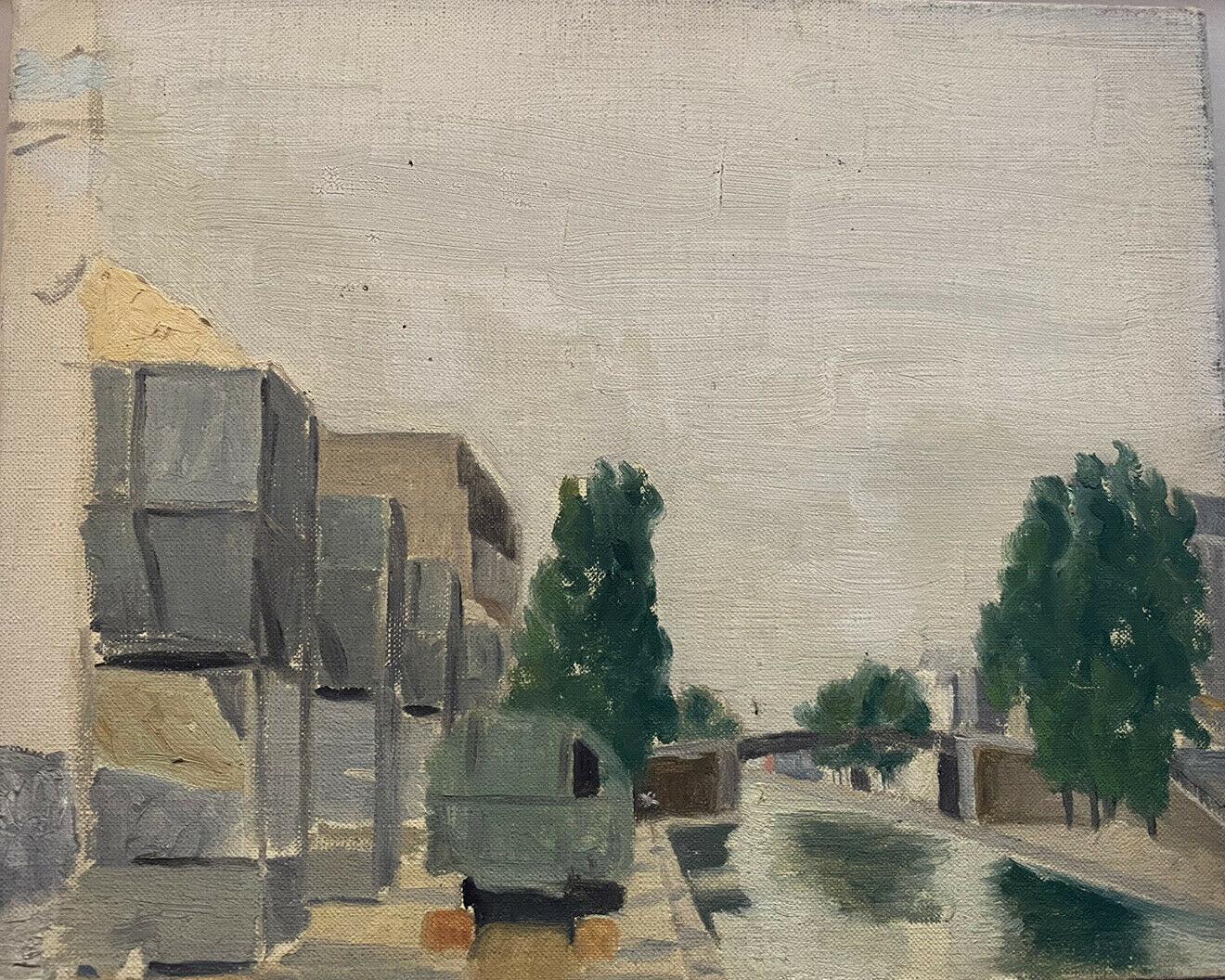Items Similar to "Virginia City, Nevada, " Joseph Cain, Mining Town, Silver Rush, Comstock Lode
Want more images or videos?
Request additional images or videos from the seller
1 of 5
Jo Cain"Virginia City, Nevada, " Joseph Cain, Mining Town, Silver Rush, Comstock Lode
About the Item
Joseph Cain
Virginia City, Nevada
Oil on masonite
21 5/8 x 36 1/2 inches
Signed lower right
A painter, muralist, and art educator, Joseph Cain's work was consistently infused by the color and vibrancy of his native New Orleans, even as he pursued a career that took him far from home. Beginning at the age of sixteen, his educational journey led him first to the Art Institute of Chicago and then to the Art Students League in New York, where he was instructed by Kenneth Hayes Miller and Kimon Nicolaides. He later studied under the Abstract Expressionist Hans Hoffman. A 1929 Carnegie Fellowship funded a year's enrollment at the Sorbonne in Paris and travel throughout Europe; Cain also received multiple Tiffany Foundation Fellowships.
Using thickly applied paint, layered color planes, and multiple perspectives, Cain created paintings, including streetscapes, marine scenes, and landscapes, which were sometimes categorized as "decorative expressionism" beginning in the late 1930s. In 1932, Cain's entry to the First Biennial Exhibition of Contemporary American Painting at the Whitney Museum of American Art hung in the exhibition's entry way; other works were shown at such prestigious venues as the Museum of Modern Art, American Art, Pennsylvania Academy of the Fine Arts, National Academy of Design, and Carnegie Institute. He also executed a monumental mural at New York State Training School where he was employed as a teacher. While living in New York during this period, Cain was an integral member of a contemporary art collective known as "The Group," whose participants included Milton Avery, George Biddle, Robert Gwathmey, Marsden Hartley, John Marin, and many other important modernists.
In 1944, Cain joined the faculty at the University of Rhode Island, establishing and chairing the art department for over two decades. Cain continued to paint long past his retirement from teaching, often returning to New Orleans subject matter in canvases that capture the bright color and festive energy of his birthplace.
- Creator:Jo Cain (1904)
- Dimensions:Height: 25.75 in (65.41 cm)Width: 40.75 in (103.51 cm)
- Medium:
- Movement & Style:
- Period:
- Condition:
- Gallery Location:New York, NY
- Reference Number:1stDibs: LU1841211567992
About the Seller
5.0
Platinum Seller
These expertly vetted sellers are 1stDibs' most experienced sellers and are rated highest by our customers.
Established in 2021
1stDibs seller since 2022
61 sales on 1stDibs
Typical response time: 1 hour
- ShippingRetrieving quote...Ships From: Larchmont, NY
- Return PolicyA return for this item may be initiated within 3 days of delivery.
More From This SellerView All
- "Tabac" Charles Green Shaw, Tobacco, Smoking, Park Ave Cubist, AAABy Charles Green ShawLocated in New York, NYCharles Green Shaw Tabac, circa 1935 Signed on the reverse Oil on canvasboard 5 3/4 x 8 3/4 inches Provenance: Washburn Gallery, New York, 1982 Private Collection (acquired from the above) Christie's, The Collector, October 20, 2021, Lot 307 Private Collection, Scarsdale, New York (acquired directly from the above) Literature: Hilton Kramer, "Charles Shaw: In the Minimal Tradition," New York Times, February 21, 1982, Section 2, p. 25. Charles Green Shaw was born in 1892 to a wealthy New York family. He lost both his parents at a very young age; his mother died when he was just three years old. Despite the early loss of his parents, Shaw lived the whimsical life of a New York socialite. As a beneficiary to an inheritance based in part upon the Woolworth fortune, he was brought up surrounded by the well-bred, well-groomed and well-moneyed citizens of New York’s elite social class. His social status as an adolescent was cultivated while spending summers in Newport and attending Christmas balls at Mrs. W.K. Vanderbilt’s. At age six, Shaw began to take an interest in drawing, and by nine, he was known to have a fondness for sketching historical costumes. After graduating from Yale University in 1914, Shaw spent a year studying at Columbia University’s School of Architecture. Subsequently he served for eighteen months as a Lieutenant in World War I. After his service, Shaw returned to New York and tried his hand as a businessman selling real estate, but his attempt was short lived. In the early 1920s, Shaw began his career as a journalist and novelist. He achieved professional success, writing consistently for magazines such as The New Yorker, Vanity Fair and The Smart Set. Shaw’s writing was a record of his approvals and disapprovals of the social crowd to which he belonged. His profession along with his social pedigree, brought him in contact with a number of the most significant figures of the 1920s such as, F. Scott Fitzgerald, Sinclair Lewis, George Gershwin, George Jean Nathan and the American artist George Luks. Some of his profiles included celebrity caricatures used as illustrations, these were the publics’ first look at Shaw’s artistic ability. In 1928, a collection of Shaw’s articles and interviews were published in one volume titled, The Low Down. Just previous to the stock market crash and the end of the Jazz Age, Shaw left New York and traveled to Paris and London. He arrived in Paris in 1929. In an autobiographical note Shaw suggests it was on this trip when he first began to paint seriously. London also acted as a great source of motivation for the budding artist. He began to sketch everyday in St. James’s Park, making large pastels of its vistas in the style of Cezanne. When he returned to New York in 1932, Shaw considered himself a painter. Success for Shaw came quickly with his first solo exhibition mounted at the Valentine Gallery in 1934. The following year Albert Eugene Gallatin included works by the artist in an unprecedented solo exhibition at his Gallery of Living Art at New York University. Shaw further cemented his reputation as an artist through his association and friendship with fellow abstract artists Morris and Gallatin. The trio soon was regarded as ‘the Park Avenue Cubists’. As a founding member of the American Abstract Artists, Shaw became an impassioned defender of the style. His 1938 essay in the American Abstract Artists yearbook, “A Word to the Objector”, acted as a defense against those who failed to see the illustrative quality of abstract art and scolded those who disregarded American artists as serious Abstractionists. He was also an influential force at the Museum of Modern Art, where he sat on the Advisory Board from 1936 to 1941. In the later years of Shaw’s life he continued to produce abstract paintings, yet in a more private manner. He was known to be a reserved man— a ‘gentleman’; not much is known about his personal life in these later years. During this time he maintained his career as a writer, publishing the well-known children’s book, It Looked Like Spilt Milk in 1940 and two books of poems in 1959 and 1962. In 1974, Shaw died...Category
1930s Cubist Landscape Paintings
MaterialsOil, Board
- "Venice Canal, Italy" Claude Venard, French Post-Cubist Mid-Century ModernBy Claude VenardLocated in New York, NYClaude Venard (French, 1913 - 1999) Venice Canal, Italy, circa 1950-55 Oil on canvas 24 x 24 inches Signed lower center Provenance: Private Collection, Massachusetts The authenticity of this work has been confirmed by Galerie Felix Vercel. Claude Venard was a notable exponent of the French mid-century post-Cubist movement. He was born to bourgeois parents from Burgogne in Paris, on March 21, 1913. At the age of 17, he enrolled and attended the Ecole des Beaux-Arts, but remained for only two days, not adhering to the school's academic style. Instead, he spent the following six years at the École des Arts Appliqués, taking evening classes and embracing the contemporary Parisian art scene, all the while becoming recognized in its circles. Not able to support himself as an artist, by 1936 he found employment as a restorer at the Louvre, further honing his artistic skills. Paris of the period was dominated by an art trend that strongly favored abstraction. Following a group show at the Galerie Billet-Worms in 1935, art critic Waldemar George declared: "Let's be young again! Painting is not dead… Its course has not stopped. Forces Nouvelles is born." Venard contributed and initially adhered to the strict disciplines of the Forces Nouvelle group. But as with many of his fellow members, he soon abandoned it seeking individual expression. Following WWII, Venard rekindled friendships with past Forces Nouvelles members, joining Pierre Tal-Coat, André Marchand, André Civet...Category
1950s Cubist Landscape Paintings
MaterialsOil, Canvas
- "Neighborhood Shivaree, " Fred E. Robertson, Grandma Moses, Self-Taught LandscapeLocated in New York, NYFred E. Robertson (1878 - 1953) Neighborhood Shivaree, 1945 Signed and dated lower left Oil on masonite 16 x 20 inches Exhibited: Buffalo, The Buffalo Fine Arts Academy, Albright A...Category
1940s Folk Art Landscape Paintings
MaterialsMasonite, Oil
- "Swapping Horses" Fred E. Robertson, Grandma Moses, Self-Taught LandscapeLocated in New York, NYFred E. Robertson (1878 - 1953) Swapping Horses, 1947 Signed and dated lower right Oil on masonite 12 5/8 x 24 inches Fred Robertson, like his more famous older sister, Anna Mary Ro...Category
1940s Folk Art Landscape Paintings
MaterialsMasonite, Oil
- "French Cathedral, " Emilio Trad, Modern Cityscape ArchitectureLocated in New York, NYEmilio Trad (Argentinian, b. 1953) Untitled, 1978 Oil on Masonite 18 x 14 inches Signed and dated on the reverse Emilio Trad was born in 1953, in Buenos A...Category
1970s Modern Landscape Paintings
MaterialsOil, Masonite
- "Crane, " Decorative Japanese School Painting of White BirdLocated in New York, NYJapanese School Crane Oil on paper, laid on Masonite 59 1/2 x 47 inches Signed in JapaneseCategory
20th Century Animal Paintings
MaterialsMasonite, Paper, Oil
You May Also Like
- Abella Town Original Landscape Cubist acrylic paintingBy Juan Jose Abella RubioLocated in CORAL GABLES - MIAMI, FLAbella. Original landscape cubist acrylic painting Juan Jose Abella Rubio was born in Estercuel, a hamlet anchored in the Teruel mining basin in March 1944. In his painting the och...Category
Late 20th Century Cubist Landscape Paintings
MaterialsWood, Oil
- New York, Architectural Composition I - Architectural CityscapeBy Lyonel FeiningerLocated in London, GBThis oil painting is signed by the artist "Feininger" in the lower right corner. It was executed in 1940. It is also inscribed ‘Lyonel Feininger 1940 Architectural Composition I New ...Category
1940s Cubist Landscape Paintings
MaterialsCanvas, Oil
- La Seine et la Tour Eiffel, vue d'un balcon, painting by Louis Marcoussis, 1925By Louis MarcoussisLocated in London, GB*UK BUYERS WILL PAY AN ADDITIONAL 5% IMPORT DUTY ON TOP OF THE ABOVE PRICE La Seine et la Tour Eiffel, vue d'un balcon by Louis Marcoussis (1878-1883) Oil on canvas 33 x 66 cm (13 x 26 inches) Signed lower left, Marcoussis Executed in 1925 Provenance Alice Halicka (the artist's wife), Paris Blanche Fabry Tézé, New York Stern Pissarro Gallery...Category
1920s Cubist Landscape Paintings
MaterialsOil, Canvas
- Cubist VillageBy Renato ParesceLocated in Wien, 9Renato Paresce, Cubist Village, 1914, Oil on Canvas, 33 x 24 cm. Signed lower left.Category
1910s Cubist Landscape Paintings
MaterialsCanvas, Oil
- Caithness Harbour - Scottish Cubist art marine oil painting Founder 1922 GroupLocated in London, GBThis art historically interesting oil on panel painting is by Scottish artist David William Gunn. Painted in 1927 it is of Caithness harbour in Scotland. The style is Scottish Cubist...Category
1920s Cubist Landscape Paintings
MaterialsOil
- MID CENTURY FRENCH OIL PAINTING - BESIDE THE CANALLocated in Cirencester, Gloucestershire"The Canal" by Geneviève Zondervan (French 1922-2013) stamped verso oil painting on canvas canvas: 8.75 x 10.5 inches Original oil painting on canvas by the French artist, Genevièv...Category
Mid-20th Century Cubist Landscape Paintings
MaterialsOil





